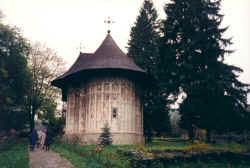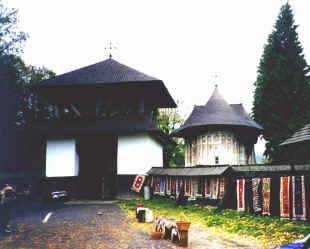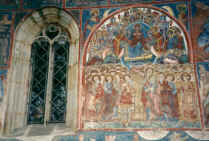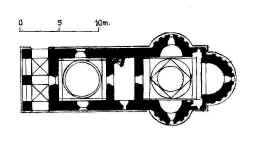Humor
 The church of the Dormition of the Virgin at Humor dates from 1530, as
attested by an inscription engraved in stone near the entrance on the outer wall of the
church. It was founded by the boyar Teodor Bubuiog, Chancellor of Petru Rareş, who is
buried here with his wife Anastasia, and replaced an earlier church that had been
destroyed. But these were insecure times when looting and fires resulted from social
unrest or exterior attacks. The monastery was enclosed in defensive walls in 1641. Today
only a massive tower and the belfry remain, and a wooden stockade hung with colorful
local rungs for sale replaces the walls. The monastery was set on fire by the Cossacks in
1653, and in the eighteenth century, when the Austrians occupied Bucovina and suppressed
the Orthodox monasteries (1786), it became a simple parish church. It was re-established
as a convent in 1990. A new church with gleaming metal roof stands on a hill nearby.
The church of the Dormition of the Virgin at Humor dates from 1530, as
attested by an inscription engraved in stone near the entrance on the outer wall of the
church. It was founded by the boyar Teodor Bubuiog, Chancellor of Petru Rareş, who is
buried here with his wife Anastasia, and replaced an earlier church that had been
destroyed. But these were insecure times when looting and fires resulted from social
unrest or exterior attacks. The monastery was enclosed in defensive walls in 1641. Today
only a massive tower and the belfry remain, and a wooden stockade hung with colorful
local rungs for sale replaces the walls. The monastery was set on fire by the Cossacks in
1653, and in the eighteenth century, when the Austrians occupied Bucovina and suppressed
the Orthodox monasteries (1786), it became a simple parish church. It was re-established
as a convent in 1990. A new church with gleaming metal roof stands on a hill nearby.

|
Baskets of decorated eggs
and colorful local rugs are put on display on wooden stockade along the walk leading up to
the belfry gate. |
The church, topped by a cross-shaped shingled roof, is steepleless, indicating that it
was not built by a ruling prince. The tall walls therefore did not need buttresses and
offer a plain surface for the frescoes, which date from 1535. They have suffered great
losses, although the south side is relatively well preserved. The dominant  colors
are dark red, blue, and green. The Virgin's Council besides the Gothic window is
particularly beautiful. More damaged is the Siege of Constantinople that covers the
lower part of the wall below it. Both form part of the "Hymn to the Virgin,"
after a poem dedicated to her in thanksgiving for her intervention in saving the city of
Constantinople from a Persian attack in A.D. 626. In a wonderful
political spin, considering the Ottoman threat to Moldavia, the Siege depicts the
enemy as turbaned Turks rather than Persians. Unusually, Toma of Suceava, the master
painter here, has signed a self-portrait that depicts him as a Moldavian horseman
attacking a Turk.
colors
are dark red, blue, and green. The Virgin's Council besides the Gothic window is
particularly beautiful. More damaged is the Siege of Constantinople that covers the
lower part of the wall below it. Both form part of the "Hymn to the Virgin,"
after a poem dedicated to her in thanksgiving for her intervention in saving the city of
Constantinople from a Persian attack in A.D. 626. In a wonderful
political spin, considering the Ottoman threat to Moldavia, the Siege depicts the
enemy as turbaned Turks rather than Persians. Unusually, Toma of Suceava, the master
painter here, has signed a self-portrait that depicts him as a Moldavian horseman
attacking a Turk.
 Tall arches,
probably adopted from Wallachian models, open the porch to the outside and daylight.
Within it the Last Judgment covers the entire surface of the west wall with its
river of fire and its depiction of the sea giving up its dead to judgment – obscurely
symbolized by a woman mounted on a dolphin, holding a ship. The Tree of Jesse has been
moved from its traditional place on the south wall to the north face.
Tall arches,
probably adopted from Wallachian models, open the porch to the outside and daylight.
Within it the Last Judgment covers the entire surface of the west wall with its
river of fire and its depiction of the sea giving up its dead to judgment – obscurely
symbolized by a woman mounted on a dolphin, holding a ship. The Tree of Jesse has been
moved from its traditional place on the south wall to the north face.
The splendid interior frescoes, cleaned some twenty years ago under an UNESCO
project, include two donor portraits: Teodor Bubuiog, the founder, and his wife appear in
the Burial Chamber, and Petru Rareş with his second wife in the nave. The pictures
reproduced here were taken in 1998, when photography was still permitted. (See Conservation.)
more pictures
 The church of the Dormition of the Virgin at Humor dates from 1530, as
attested by an inscription engraved in stone near the entrance on the outer wall of the
church. It was founded by the boyar Teodor Bubuiog, Chancellor of Petru Rareş, who is
buried here with his wife Anastasia, and replaced an earlier church that had been
destroyed. But these were insecure times when looting and fires resulted from social
unrest or exterior attacks. The monastery was enclosed in defensive walls in 1641. Today
only a massive tower and the belfry remain, and a wooden stockade hung with colorful
local rungs for sale replaces the walls. The monastery was set on fire by the Cossacks in
1653, and in the eighteenth century, when the Austrians occupied Bucovina and suppressed
the Orthodox monasteries (1786), it became a simple parish church. It was re-established
as a convent in 1990. A new church with gleaming metal roof stands on a hill nearby.
The church of the Dormition of the Virgin at Humor dates from 1530, as
attested by an inscription engraved in stone near the entrance on the outer wall of the
church. It was founded by the boyar Teodor Bubuiog, Chancellor of Petru Rareş, who is
buried here with his wife Anastasia, and replaced an earlier church that had been
destroyed. But these were insecure times when looting and fires resulted from social
unrest or exterior attacks. The monastery was enclosed in defensive walls in 1641. Today
only a massive tower and the belfry remain, and a wooden stockade hung with colorful
local rungs for sale replaces the walls. The monastery was set on fire by the Cossacks in
1653, and in the eighteenth century, when the Austrians occupied Bucovina and suppressed
the Orthodox monasteries (1786), it became a simple parish church. It was re-established
as a convent in 1990. A new church with gleaming metal roof stands on a hill nearby.


